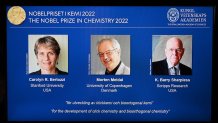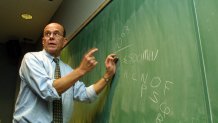This year’s Nobel Prize in chemistry has been awarded in equal parts to Carolyn R. Bertozzi, Morten Meldal and K. Barry Sharpless for developing a way of “snapping molecules together” that can be used to design medicines.
Their work, known as click chemistry and bioorthogonal reactions, is used to make cancer drugs, map DNA and create materials that are tailored to a specific purpose.
Sharpless, a W. M. Keck professor at La Jolla's Scripps Research, first proposed the idea of connecting molecules using chemical “buckles” around the turn of the millennium, said Johan Aqvist, a member of the Royal Swedish Academy of Sciences that announced the winners at the Karolinska Institute in Stockholm.

Get San Diego local news, weather forecasts, sports and lifestyle stories to your inbox. Sign up for NBC San Diego newsletters.
Sharpless, 81, previously won a Nobel Prize in 2001 and is now the fifth person to receive the award twice.
Meldal, 68, based at the University of Copenhagen, and Sharpless independently found the first such candidates that would easily snap together with each other but not with other molecules, leading to applications in the manufacture of medicines and polymers.
“The problem was to find good chemical buckles,” Aqvist said. “They have to react with each other easily and specifically.”
U.S. & World
Bertozzi, 55, who is based at Stanford University “took click chemistry to a new level,” the Nobel panel said.
She found a way to make the process work inside living organisms without disrupting them, establishing a new method known as bioorthogonal reactions. Such reactions are now used to explore cells, track biological processes and design drugs that can target diseases such as cancer more precisely.
"Doing chemistry inside human patients to make sure that drugs go to the right place and stay away from the wrong place,” Bertozzi explained.

Jon Lorsch, director of the U.S. National Institute of General Medical Sciences, which supports the work of Bertozzi and Sharpless, described click chemistry and bioorthagonal chemistry as “sort of like molecular Lego — you have a group on one molecule that specifically attaches to a group on another molecule," like Lego clicking together.
“That makes it possible to attach molecules in very specific pre-defined ways," he said, and gives scientists a very precise tool to build complex new molecules that can be used for drugs, synthetic materials and other uses.
However, the first iteration of click chemistry could not initially be used to work on living cells. “The original click chemistry used copper as a catalyst to join molecules,” Lorsch said. “But the trouble is that copper is toxic to most living systems at higher concentrations."
Bertozzi then devised a way to jumpstart the reactions without copper or other toxic solvents — broadening the applications of the molecular Lego to human and animal tissues.
“Being able to work without dangerous solvents, opened many news doors — it enabled scientists to work on new types of reactions that actually take place within the human body,” said Angela Wilson, president of the American Chemical Society.
For example, that has allowed scientists to attach dyes to cancer cells to track their movements and analyze how they differ from healthy tissue.
Wilson believes that the advances of this year's Nobel laureates “will allow more individualized medicine in the future because we can really track things much better within the human body.”
Last year the prize was awarded to scientists Benjamin List and David W.C. MacMillan for finding an ingenious and environmentally cleaner way to build molecules that the Nobel panel said is "already benefiting humankind greatly.”
A week of Nobel Prize announcements kicked off Monday with Swedish scientist Svante Paabo receiving the award in medicine for unlocking secrets of Neanderthal DNA that provided key insights into our immune system.
Three scientists jointly won the prize in physics Tuesday. Frenchman Alain Aspect, American John F. Clauser and Austrian Anton Zeilinger had shown that tiny particles can retain a connection with each other even when separated, a phenomenon known as quantum entanglement, that can be used for specialized computing and to encrypt information.
The awards continue with literature on Thursday. The 2022 Nobel Peace Prize will be announced on Friday and the economics award on Monday.
The prizes carry a cash award of 10 million Swedish kronor (nearly $900,000) and will be handed out on Dec. 10. The money comes from a bequest left by the prize’s creator, Swedish inventor Alfred Nobel, in 1895.



